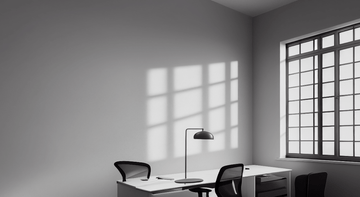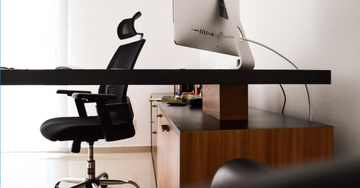
If you work from home, you know how important it is to have a comfortable and functional workspace. This is the reason why we work so hard to complete our home office essentials, from ergonomic chairs and tables to mechanical keyboards and wide monitors. Many of us, however, overlooked the importance of workspace lighting.
You may not realize it, but your home office lighting plays a huge role in your wellbeing. Good lighting in the office can create a good work atmosphere, enhance your focus, and even make you healthier. Poor lighting in your workstation can cause eye strain, headaches, and fatigue.
In this guide, we’ll be giving some tips to elevate workspace lighting. Whether you are looking for a way to improve the lighting of your home office or you’re planning to build a new workspace, these helpful tips are for you.
1. Let the Natural Light In

However, it's important to strategically position your work table to make the most of the natural light. A wrong position could result in excessive glare or distracting shadows.
Our recommendation is to position your computer screens perpendicular or parallel to the windows. This is an ideal position to avoid glare, allowing you to enjoy the view outside when you need to rest your eyes.
2. Filter the Light Using Solar Shades and Curtain

There is no denying that natural light is good for home offices. However, there are times when it brings excessive heat, especially during the afternoon. This is why you need solar shades to reduce the heat of natural light without compromising its quality and visibility.
If you can’t find solar shades, sheer curtains can also work. They can diffuse and soften the outside light. Moreover, quality fabric can provide a level of luxury to your room.
3. Use Indirect Lighting in the Office

Whether it a natural or artificial lighting, keep your office lights indirect to protect your eyes. Our recommendation is to choose workspace lighting that that spread evenly in your area. Lamp shades are the perfect solution for this. It can disperse the light and create a well-lit office without any excessive glare, even during nighttime.
4. Use Task Lighting for Home Office

 Different activities in your home office require different lighting levels and directions. To avoid eye strain and increase productivity, use a specific light source for each task.
Different activities in your home office require different lighting levels and directions. To avoid eye strain and increase productivity, use a specific light source for each task.
For instance, the Eugene Lamp is perfect for your computer work and paperwork. It’s a versatile lamp that can fit into various spaces. Aside from your desk lamp, you should have a separate light for your filing area and another light source for reading and other tasks. By incorporating different types of lighting in your home office, you can be more efficient and productive.
5. Don't Be Afraid to Stylize Using Light

 We all want to work in inviting spaces. By using accent lighting and decorative lights, you can effectively improve the aesthetic of your home office. You can also add floor lamps such as Qoncept Elias to bring a sleek touch to your room.
We all want to work in inviting spaces. By using accent lighting and decorative lights, you can effectively improve the aesthetic of your home office. You can also add floor lamps such as Qoncept Elias to bring a sleek touch to your room. Let your imagination run wild. Use lighting to make your office more inviting and enjoyable.




